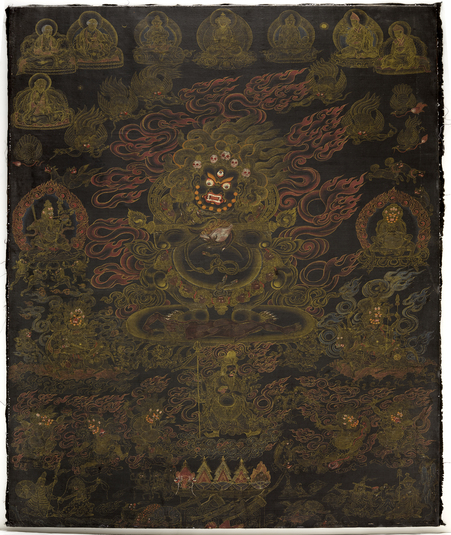
Item: Mahakala (Buddhist Protector) - Panjarnata (Lord of the Pavilion)
| Origin Location | Tibet |
|---|---|
| Date Range | 1700 - 1799 |
| Lineages | Sakya, Ngor (Sakya) and Buddhist |
| Material | Ground Mineral Pigment, Black Background on Cotton |
| Collection | Private |
Mahakala, Vajra Panjarnata (Tibetan: dor je gur gyi gon po. English: the Great Black One, Lord of the Vajra Pavilion [or Canopy]): from the Vajra Panjara Tantra.
At the top center is Buddha Vajradhara flanked by two mahasiddhas. Seated on the left side are Sachen Kunga Nyingpo, Sonam Tsemo and Dragpa Gyaltsen. Seated on the right side are Sakya Pandita Kunga Gyaltsen and Chogyal Pagpa.
"...the great Vajra Mahakala, blazing, with one face, two hands, in the right a curved knife and the left a skullcup filled with blood, held above and below the heart. Held across the middle of the two arms is the 'Gandhi of Emanation.' With three eyes, bared fangs, yellow hair flowing upward, a crown of five dry human skulls and a necklace of fifty wet, blood dripping; adorned with six bone ornaments and snakes; having a lower garment of tiger skin; flowing with pendants and streamers of various silks; in a posture dwarfish and thick, standing above a corpse. To the right is a black crow, left a black dog, behind a wolf, in front a black man, above a garuda, emanations of messengers issue forth, with Akshobhya as a crown, standing in the middle of blazing fire of pristine awareness." (Konchog Lhundrub, 1497-1557).
At the middle left side are Brahmanrupa Mahakala accompanied by four small female figures and below that Shri Devi Magzor Gyalmo riding a mule. At the middle right side are Ekajati holding a vase and below that Shri Devi Dudsolma riding a donkey.
At the lower center is a Brahman figure holding a trident and skull bowl. To the right and left sides are the Five Activity Protectors "... Kala Rakshasa with a body black in colour, one face, two hands, the right holds a curved knife, left a blood filled skullcup, wearing a ceremonial human skin and having gold earrings. ... Kala Rakshasi with one face and two hands, the right holds a gold razor, left a skullcup filled with brains and blood, wearing cloths of black silk, and having one braid."
"...the three Putras, brothers and sister. ... Putra, black, one face, two hands, the right holds a sword and the left a blood filled skullcup, adorned with silk trousers and clothes of black silk. ... Bhata, black, with a tiger skin fur coat, holding in the right a wooden stick and in the left a human heart. ... Rakshasi Ekajati (Singmo), holding in the right a gold razor and intestines in the left, blazing fire from the mouth. These five have bodies blue-black in colour, three very fierce eyes, adorned with garlands of bones and a necklace of fifty wet human heads, standing in a manner raging and trembling completely severing harmful ones."
At the bottom of the composition are five skull offering bowls along with miscellaneous gifts of weapons surrounded by cemetery scenes and wild animals. On the left side are two figures, a warrior and a black woman. On the right side are a monk (bhikshu) and a sorcerer (mantradharin). Each of these are multiplied and represent one hundred figures.
"Also to the right are others, one hundred led by a man adorned in a tiger garment. To the left, one hundred, led by a bhikshu with a large form, further followed by one hundred black mantradharins. In front, in empty spaces to the north are one hundred led by a black woman. Surrounded also by others, beyond thought, destroying oath-breakers, black dogs, black men, wolves, and the like." (Written by Ngorchen Konchog Lhundrub (1497-1557). Translated September 1995).
Rinchen Zangpo Lineage of Teachers: Vajradhara, Vajrapanjara Dakini, Brahmin Vararuchi, Pandita Deva Vajra, Shraddha Karavarma, Lochen Rinchen Zangpo, Drag Tengpa Yontan Tsultrim, Mal Lotsawa Lodro Drag, Sachen Kunga Nyingpo (1092-1158), etc.
This composition is a single painting for individual worship and does not belong to a set or series of paintings.
Black ground paintings can be dated to the end of the first millennium based on literature. A few painting examples can be seen in the 14th and 15th centuries. The earliest descriptions for black ground paintings are for wrathful figures to be drawn on a black painted surface created from charnel ground ashes. The textual source for black ground paintings is found with the Tantras of Indian Buddhist literature such as the Twenty-five and Fifty Chapter Mahakala Tantras.
Historically and traditionally, black ground paintings were appropriate only for wrathful and fearsome subjects. In the Tantric Buddhist system there are four activities associated with four principal colours: peaceful - white, increasing - yellow, powerful - red, and wrathful - black, or dark blue. In the 20th century, for the purposes of commodity and souvenir art, black ground is used with any type of figure, categorized by appearance or function, that the artist chooses to depict, without regard for religious or artistic tradition.
Jeff Watt 1-2019 (Portions of the above text have been borrowed from other entries on the HAR website).
Collection: Bonhams New York (Painting. March, 2019)
Thematic Sets
Mahakala: Panjarnata, Lord of the Pavilion (Main Page)
Mahakala: Panjarnata Masterworks (Painting & Textile)
